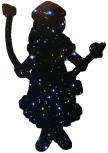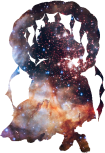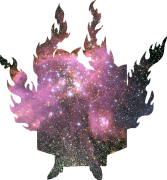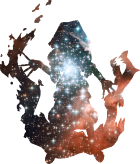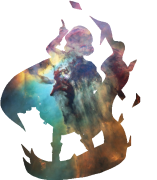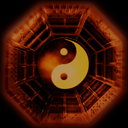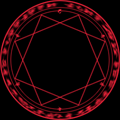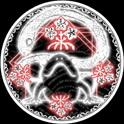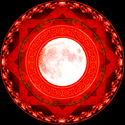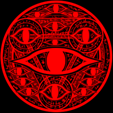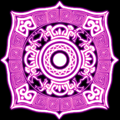Exploring the Touhou Mythosphere – Part 1: The West
This article is the first in a series intended to take a look at various resources such as blogs, wikis and archived threads that discuss Touhou from a more mythological, folkloric and spiritual angle. This is not a complete picture of people's interest or knowledge towards these topics, but from what has been gathered, the instances of people devoting serious interest towards the topic are separated both in space and time.
While even the Western Touhou Wiki highlights some of the connections to real-life spiritual traditions and folklore (enough to get me interested), Westerners showing in-depth interest have been few and far between. There's always been the scattered individual in Reddit or 4chan threads who seems to have knowledge of the deepeter inspirations, but those bothering to more systematicaly present this information are a vanishingly rare exception.
Perhaps this is simply due to the nature of subject. The various ”otaku” flavored interests are kind of an onion to be peeled, . Touhou is particularly remarkable case for this, as there is an enormous amount of people who are in it for memes and pornography. Substantial number of self-described fans have not even played the games, too dissuaded by their perceived difficulty. I'm not much of an gatekeeper myself, but I do find the situation curious and amusing.
Beyond this outermost layer, there are those who get into the games, the print works and the lore associated with them. For many it is a self contained thing. Gensokyo is Gensokyo, ZUN's iterations of Japanese beliefs and mythology are rich enough in themselves to occupy someone's interest for years. Some dance the danmaku for years, chasing higher peaks of performance. Then there are the rare ones who become interested in the real-life mythologies and spiritual traditions that have come to dwell within Touhou. Out of those, even rarer few climb the Mountain of Faith and open themselves to being taught by these traditions, and out of those, even fewer come face to face what has been deemed into realm of fantasy...
Out of those who have felt something much, much deeper at the core of Touhou, some, perhaps majority of them, have rejected it. The first hurdle to pass is Western culture condemning the numinous into either fantasy, delusion or psychology. And even when such is thought to be legit, the Western culture tends to characterize spiritual influence not stemming from monotheistic Western religions as suspicious and scary. This had led to some of the spiritualy-tinged takes becoming rather conspiratorial in nature.
A curious aside here is all the people who either jokingly or seriously say that they will go to Gensokyo after they die. While this might be a pure meme, it has very strange parallels with Pure Land Buddhism as a folk religion, especially when you consider that Matarajin is sometimes considered a wrathful manifestation of Amitabha, the Buddha who governs the Western Pure Land, a paradisical realm anyone can reincarnate into...but this is becoming a pretty long tangent worthy of it's own article.
Getting back to the matter at hand, these factors illustrate why the Western side of people showing deep interest to the origins of Touhou are so scattered. As far as I know, and some people who have reached out to me did actual research on the matter, the 4chan Esoteric Touhou threads and the Archive represent the first documented instances of serious believers attempting to systematicaly preserve their insight. I find it impossible to think that there haven't been others before us, branded as ”schizo” and jeered at by others, or then being wise enough to shut up about their anomalous experiences. The first decade after the turn of millenium saw popularization of Chaos Magic. With their attidute of ”you can just pray to anything”, I refuse to believe that the amount of Touhou fans who experimented that and got results was exactly zero. These people have simply not made themselves known. So far, everyone who has shared their experiences either in the threads or private has had them appearing in relatively tight time cluster between 2023 and 2025, which is an interesting topic in itself.
Another issues with preserving and collecting this kind of information is that everything has been dispersed into social media and discord channels. The old days of websites is mostly gone, with few weirdos like me struggling against the tide. Even the age of blogging seems to be long over. What information we have is dispersed into million tiny fragmented channels, and the various wikis are the closest thing we have to people systematicaly trying to pin down information. And with the wikis, the very concept, the very format, the dry collection of facts greatly limits the range of expression. The Touhou Wiki does a fine job presenting information about the game, but any further thinking about what it means that there is so much real life lore in Touhou is beyond it's scope.
The point of this long-winded preamble is that there is nothing else like the Archive out there, and the Western sources presented, while tending towards the mythological, even spiritual, don't (publicly at least) quite do what is done here. However, there have been some that have discovered the spiritual side of Touhou as early as 2012 and written about it. We shall take look at such a pioneer next.
Gnosisonic and the spiritual in Touhou
Gnosisonic is – or rather was – a blog maintained by ”Lance” of which not much is known about. The blog sadly has not been active since 2019. While they were active, they made posts about various topics falling under ”otaku culture”, music, games and also more personal topics. While Touhou was not the main focus of the blog, what is there presents the earliest remaining document found so far of someone in the West starting to pay attention to the spiritual qualities of Touhou. This is the post titled ”Japan's new mythology”.
This particular post, more like an article, deserves some special attention. Written in 2012, it feels the need to explain what Touhou even is. While not exactly ”new” by then, it had perhaps not as throughly broken into the Western cultural sphere yet. I remember having some ”otaku culture” aligned friends in the late 00s, early 2010s who were into Touhou and it certainly felt like a ”new” thing here in the West then.
The post presents an analysis of the games that greatly resonates with my own experiences of them. The author highlights the otherworldly qualities the games display via their combination of music, visuals, inspiration and overall atmosphere, calling ZUN's games ”refined and intentionally spiritual”. The author also pinpoints how continued interactions with the ”digital mandalas” leads into a ”strangely transcendental experience” that feels almost ”inaproriate” coming from a video game.
The author goes over ZUN's music, character designs, the general doujin culture which Touhou has it's origins in. They highlight how ZUN's designs seem to trigger some kind of frenzy to re-interpret them, and of how high quality to doujin works associated with Touhou are. The risk of Touhou becoming commercialized is talked about. Reading about ZUN forbidding the games to be ported to cellphones and how they could only be sold at doujin events feels strange 13 years later in the era of Touhou Lost Word and official Steam releases of the games.
Having gone over these points, the author then speculates on what exactly it is that makes Touhou popular, and here he presents that Touhou constitutes something of a modern Japanese mythology. The author points out how Genokyo reflect's Japan's rural past, and how the incidents are ultimately minor and bening, and in the end, the natural order of Gensokyo is always restored in the end. He also points out how much of Touhou is inspired by real life mythology and locations. Already back in 2012, Touhou pilgrimmages to Suwa Grand Shrine were a thing. One American visitor at the time commented that there were too many ema prayer boards with Touhou-themed art to even count.
There's a very curious statement in the article: ”Shinto is an animistic religion with the idea that everything in the natural world contains spirits, and that concept seems very close to the essence of Touhou itself. ” This is followed by an explanation about how the various characters in Touhou seem more archetypal, existing more ”as ideas or modes of being” than defined characters. This archetypal nature has allowed for the fandom to make the characters their own, to perpetuate them by giving them new life. The author uses the character of Houraisan Kaguya as an example of this process. She is based on an ancient myth, given new life via Touhou as ”an archetype collecting dust in the cultural subconscious that suddenly has relevance and meaning again”. This has led to a situation where according to the author the Japanese fans seem to treat her ”as a sort of household goddess”.
The author also mentions that the Touhou fandom has a rather strong erotic component to it too. At the time at least, the American fandom was trying to make strong distinctions between fanon and canon (this seems to be going on still today, with the whole Grimsokyo vs Cutesokyo sectarianism being a later development). The author however calls Touhou ”a world upon itself” and sees that this kind of ”tapestry of dreams” would inevitably find an erotic component to itself too. I peronally also believe there is – or at least can be – such an element to spirituality in general too. People fantasizing of beings we deem to be entirely phantasmal is hardly a new phenomenon, and historicaly this has interacted with spirituality, even religion.
The author ends the article talking about Renko and Maribel, apparently being intrigued at the budding, strange meta-narrative emerging from there. He points out that the black and white hats and their differing aproaches and attidutes can be seen as a yin-yang kind of analogy. And Maribel, the one who believes truth to be relative, dreams of Gensokyo.
Now, 13 years later, Maribel no longer just dreams of Gensokyo.
If in 2012 Lance talked about the spiritual, mythological and archetypal qualities of Touhou, in 2014 he took things a bit further.
Starting from talking about an Alstroemeria remix the author enjoyed, he then writes about how the tittle of the remix and the qualities of the song made him think about Zen and Shinto. In both of these religions, the spiritual is not seen as something separated from the world, but rather a part of it. In Zen, it is seen that humans put up an illusory veil of ”things” over the world, separating what is of one unified source into categories.
In Shinto, the various kami are seen as manifestations of physical phenomena. Deities and spirits associated with various parts of nature are not seen as being separate from them or lording over them, but rather being them. The author offers a rather poetic analysis of a picture of Suwako-sama, which in his opinion (and mine too) seems to highlight this idea well. ”She looks to the viewer invitingly, but the invitation seems to be to the landscape rather than to her body. The landscape, in fact, is her body...She emerges from the landscape, and it emerges from her. One and the same. ”
This particular illustration accompanied the piece of music that caused the post, and the author soon reaches quite the spiritual heights with it. Talking of how everyday consciousnes splits the world apart and shatters it, we lose sight of the greater ”cosmic signifigance” of even those things that don't seem very special to us.
The next two paragraphs of the post are worth quoting entirely on their own here:
The original meaning of the word “religion” is something like “re-binding.” A process that brings us back into contact with the source. As fragmentary as they are, this one song and one image together constitute a small mantra, a single meditation on a kind of connection. It reminds me why I love Touhou culture so much: it is essentially open-source religion, spirituality unfettered by an authoritarian structure. There is no boss, only a free play of images, sounds and ideas, and while not everything that emerges from it is great or enlightening, it provides an opportunity for serendipitous connections like this to occur. A simple curation of media–the uploading of a song onto youtube–gives a chance to the passive listener who loves the song enough to upload it to add something of their own, to say something about its essence by associating it with an image. The result is a whole greater than the sum of its parts.
Which is not to say that there’s anything monumental here. It’s a little thing, not grand at all–just a light reminder of some very primal concepts. On their own, perhaps the song and image don’t accomplish anything but a temporary feeling of relaxation and release from the agitated daily cycles of the mind. A small meditative moment of reconnection. The great thing about Touhou, however, is that this is just one such experience out of thousands–each of them novel and unique, but all of them connected, all emanating from the same source.
All of this is very true and it is extremely fascinating to see someone in 2014 call Touhou ”open-source religion, spirituality unfettered by an authoritarian structure”.
Gnosisonic's writings about Yugen in the fan art of Touhou has been in the external sources here for a while, and they are also a worthwhile read. Lance, the author of the blog, also produced an article talking about his love for the music of the aforementioned Alstroemeria records. While it isn't as relevant to this site's interests, I present it for completion's sake.
Lance's writings on Touhou are deeply resonant with me. They present much of the same things I have tried to present here, and in a much more compact, arguably aproachable form. I hope they are happy doing whatever their current ventures may be. You have been seen, you have been heard, you have been remembered and you have been spoken for.
Touhou Project Icebergs
A few years ago there was a big trend in making ”iceberg pictures”, which basicaly was a format for presenting information that became more ”deeper” or ”darker” as the picture went downwards. These ”icebergs” were actually a quite fascinating cultural trend, reflecting a larger shift towards more conspiratorial and – yes – esoteric thinking in Western culture.
These icebergs are esoteric both in the sense of trying to look below the surface and in the sense that often these icebergs would posit information that would go contrary to common perceptions of reality. This ”looking below the surface” could manifest in multiple ways – an obsessive deep dive into some particular form of media, but also scrutinization of our social and political paradigms, or questioning the nature of reality. When the icebergs would offer radicaly new perspectives to consider – be it the ”great mud flood” (what a strange fad and an allegory if there ever was) or some game actually taking place in real life, they would radicaly go again concencus perspectives on reality.
This conspiratorial, esoteric shift in culture was, or perhaps is, of course driven by a very real sense that reality is not the same as the concensus reality. This is of course true in a couple of different extremely flat and mundane ways. Concensus reality is strongly engineering by those with enough influence and power to influence the kind of information people perceive, and according the modern science ”reality” is 99% empty space with some fields of energy of different resonance scattered in. Everything else is draped over by the human perceptive apparatus, and the human perceptive apparatus did not evolve to perceive ”reality” but to survive.
But ”concensus reality is not reality” is also true in more ”esoteric” ways too. There are very real (as much as anything is real) aspects of the world that we have condemned into fantasy and delusion. Yet even at the height of the materialistic paradigm, people kept having spiritual, numinous, anomalous experiences. What was wrongly condemned to be unreal then of course wants to be free, to once again become part of what we describe as ”reality”. Is it then any wonder that given the most intense media of communication ever devised, impossible to fully manage or curate, the human culture then starts shifting once again towards the numinous..?
But perhaps I've waxed poetic enough about the cultural trends that gave birth to these ”icebergs”. As a large cultural phenomenon, Touhou project inevitable saw several of these emerge. I won't go over all of these, as there are multiple versions of them in existence. Most of these refer to bits of lore from very much in-game perspective, or to things surrounding the circumstances of the creations of the games. Occasionally, bit more mythological, stranger and conspiratorial bits and pieces would drift int. Let's take a look at one of these icebergs.
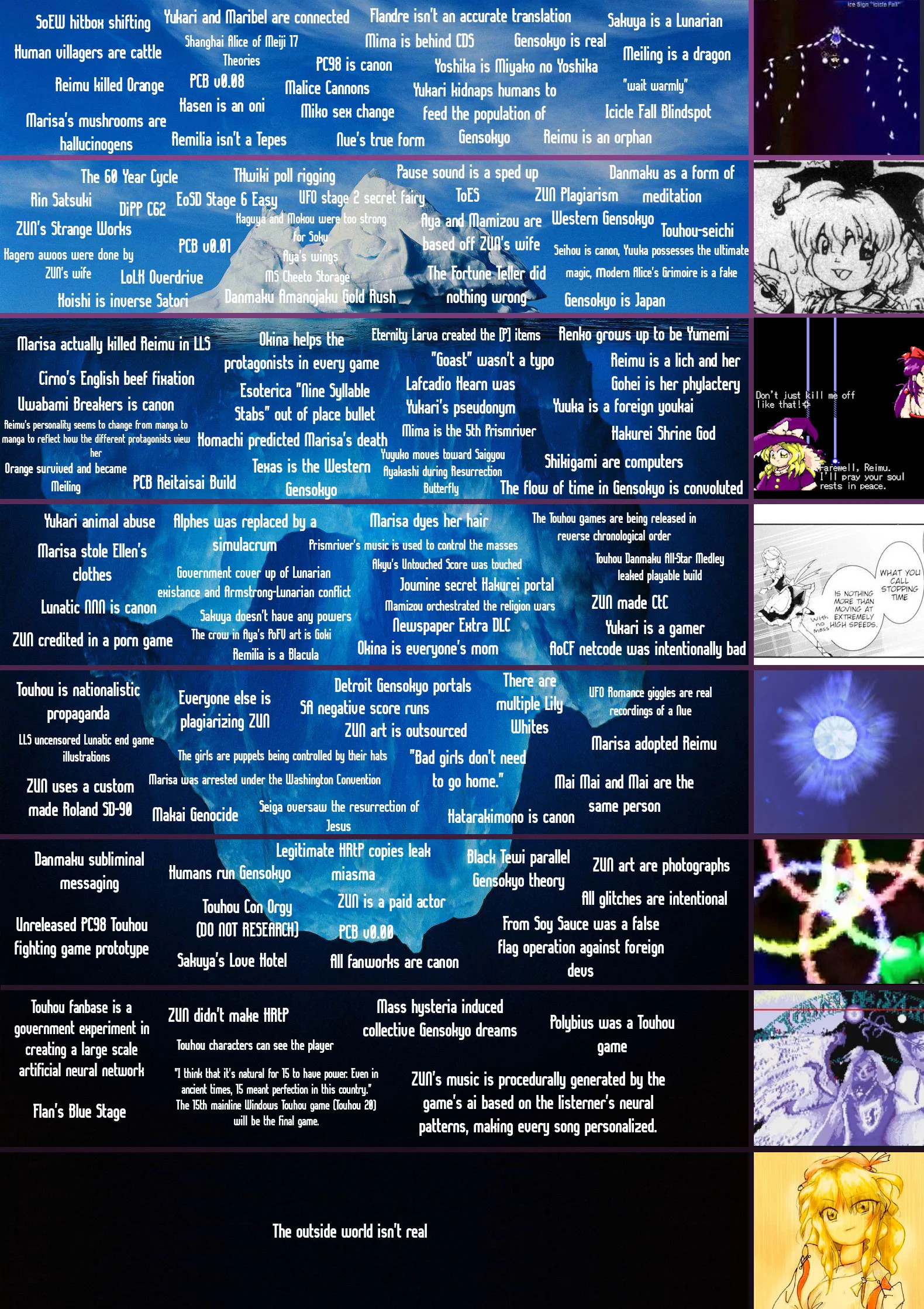
This particular iceberg has perhaps the ”strangest” flavor of the several Touhou-related ones floating around. While there are some entries which are most certainly intended to be jokes, there's a few curious bits that deserve closer attention.
The idea that the real-life Joumine Jinja served as the basis – or is – the same as the Hakurei Shrine has appeared also in some other icebergs, sometimes simply as ”Joumine shrine” or ”Joumine jinja”. For those who want to read more about it, please check the Gensokyo is a Place on Earth? Section of the Archive. Where this idea came and how it was disseminated is very unclear, but there is some evidence linking a deity connected to Mt. Haku – a shugendo holy site – and the Joumine Shrine. Hakuba was also ZUN's childhood town. The possible origin point of this information is the Eastern Holy Land wiki, which has a page for it, and which I have seen quoted several times on /jp/. It's interesting how surprisingly wide this idea – or at least the very likely connection of this shrine to Touhou – has traveled.
Presumably this refers to the meditative qualities of playing the Touhou game. I find this statement to be quite agreeable. It's very interesting to see that others have possibly discovered the meditative qualities of playing the Touhou games. There's also a secondary implication – that within Touhou lore, the danmaku contests are a form of meditation to those who participate in the spellcard duels. Considering how in Japanese culture all kinds of pursuits that can be done with intensity, be it flower arranging or martial arts, are seen as carrying a kind of spiritual value, this is also a valid interpretation.
I strongly believe that the complex flower-like, mandala-like mathematical art that the games prominently feature carries some kind of link to the various spirits within the games. They are attached with names, statements and aesthetics that carry meaning and connections - a certain someone who reached out to this site described them as "business cards". The danmaku pattern are essentially mandalas, both in the sense that they help to establish trance states and that they carry a link to the numinous. To someone without tools to conceptualize this, they would indeed perhaps feel like ”subliminal messaging”.

I have no idea if this refers to a real incident or not, but I would be very curious to hear if such truly happened. I wouldn't go as far as to say that I have ”been to Gensokyo”, but I have had experiences that took place either there or in some interstitial state between here and there. Through the Archive and the threads, I have come to contact with multiple people having extremely vivid dreams involving the spirits of Gensokyo, sometimes even locations of Gensokyo. I too have dreamt of the characters multiple times, yet they have been more within my dreamspace. Is this a throwaway line or something that happened? It remains to be seen...
That's because they are real spirits.
The end of the iceberg serves a good pivot to the next topic, which is...
The Gensokyo Conspiracy threads
The Gensokyo Conspiracy threads served as a kind of a precursor to the Esoteric Touhou threads on 4chan's /jp/. While most of the discussions was strictly from in-game lore POV and rather light-hearted, there were certain posts that steered towards real-life connections and the mythologies that are featured in Touhou. The real-life orientation of the threads grew as time went by, eventually becoming the Esoteric Touhou threads.
The first instance of a thread dedicated explicitly for such ”Gensokyo Conspiracies” I have been able to find so far is from August 2023. In many ways, it is an offshoot of the lore discussions on /jp/, which by their nature occasionaly dip into real-life lore because there is so much of it in Touhou. It also carries all the shades of the typical cutesokyo vs grimsokyo debates that color Touhou lore discussions in /jp/. Nevertheless, there are some curious ideas and posts to be found there.
Among some notable ideas that there are multiple ”gensokyos”, that Gensokyo can be seen from the orbit and that the world governments are covering up the existence of Gensokyo and similar places. The idea of the Lunarians interacting with world governments was also raised. Another point of discussion was what is the ”true form” of the various youkai, with opinions varying between their depiction as women being just artistic license versus them using such an appearance as a tool of deception.
There's some discussion about real-life locations tied to Gensokyo, such as the Yatsugatake Mountains and Suwa. The fact that the real-life inspiration for the Hakurei Shrine is nearby is highlighted, and it's speculated that kami and youkai would have altered the landscape of Gensokyo after the Hakurei Barrier was erected.
A fascinating post that intersects between Touhou lore and real-life traditions presents a theory that Kikurihime is the Hakurei God. This is based on the fact that in Highly Responsive to Prayers, the Hakurei Shrine's torii hate doesn't read ”Hakurei” but rather ”Hakusan”. Hakusan is a sacred mountain and an important location to Shugendo. The main shrine of Hakusan area is called Shirayama Hime Shrine. There is a very relevant connection between this shrine and the Jomine Shrine in Hakuba, ZUN's childhood town. It's known that the Jomine Shrine enshrines along with other deities the Shirayama Hime, also known as Kikurihime. Kikurihime is a very curious deity, appearing in Japanese mythology only once. She mediates between Izanagi and Izanami in Yomi, the land of the dead. She's regarded as a deity of love, marriage and negotiation. The deity of Mt. Haku was originally believed to be a dragon goddess, but over time became conflated with Kikurihime. She's also in Touhou as the character of Kikuri, her location and depiction being possibly influenced by Shin Megami Tensei which ZUN is known to be a fan of.
The influence of SMT is most prominent on the pc98, though Japanese fans have uncovered later throughlines of influence. The thread does go into the pc98 canon, which feels almost like some kind of murky, pre-flood prehistory of Touhou in a way. Most notable the depiction of Sariel is brought forth, and her connection to the mythological grigori, Watchers, which later gave the name the egregores.
Later threads pivoted to direction which eventually led into the Esoteric Touhou threads, taking a much more IRL-oriented aproach. The Gensokyo Conspiracy X-thread opened directly with the premise that Gensokyo exists, the powers that be are covering up it's existence, talks of the power of belief and how there is evidence for strange happenings in Japan and on the Moon. The posited reality of Gensokyo brought in people talking about real-life ideas related to faith, spirituality and then numinous, and the rest is /jp/ history. There was also a third thread less than a month later, which swerved towards the numinous almost immediatedly.
Because I participated in them, I can not write about them as a an observer. It does appear that these threads represented a ”vibe shift” in the board when it came to discussions about Touhou lore. The bridge between fictional depictions of the numinous and how it is in real life (if there is ultimately any kind of distinction, in some kind of nondual way) was built and those who wanted to cross it crossed it.
Perhaps of some interest is the connection these albums have to the release of the Taboo Japan Disentanglement album and the total solar eclipse of 2024, as they clustered around the eclipse (8th april) and the announcement (9th of april).
Yamayuandadu and the current peak of scholarly interest in Touhou
We've now gone over some kind of murky trajectory from the earliest whispers of Touhou's spiritual potency through the dark depths of icebergs back into the present moment. In parallel with this development of interest towards the esoteric in Touhou, there has been another, much, much more popular and acceptable track: an interest towards the mythologies present in Touhou, as a more scholarly interest.
As with the more spiritualy-tinged side of things, this too has been rather scattered. Every single lore thread, be it on 4chan, Reddit or elsewhere, has the the handful of scholarly types who know of the real-life mythological inspirations behind the lore. Touhou Wiki too has, in the case of some characters very extensive, notes regarding real life mythology and history tied to Touhou lore.
Some however went above and beyond when it came to the making a coherent presentation of these inspirations. Out of what I have been able to find, there is one blog that stands out in particular.
Yamayuandadu is a very high-quality example of Western works focusing on the mythological side of Touhou. It's a blog focusing on a variety of historical and mythological topics, and some of these topics included the mythologies that contributed to the creation of Touhou. As of 2024, this particular series of articles is ”on indeterminate hiatus and unlikely to ever return.” While this is unfortunate, what is there is of extremely highly quality and very well-researched.
In particular, the articles are diligently sourced. Sourcing and lack of thereof is the biggest weakness of this site, and Yamayuandadu is the day to my night. Anyone interested in further reading into Japanese mythology will have a feast with the blog, if they somehow wouldn't be satisfied with what has been written in there. The perspective is very mainstream scholarly, the mythologies are treated as that – mythologies.
As there are quite a number of articles related to the matter at hand in the blog, it's hard for me to pick a single one or even two for closer analysis. The ones related to Okina-sama are of great personal interest, but I would suggest all potential readers to simply pick one they find most fascinating and go from there. It's all of exceptionally high quality and scholarship for Touhou-related content.
While Yamayuandadu might have gotten enough of Touhou Scholarship, the work presented in the blog has inspired someone to do a master's thesis in Japanese humanities. As it tends to be, once the torch is lit, it wants to get passed on. Interest towards the mythologies and history that inspired Touhou is certainly not going away.
The Western Eastern Holy Land Pilgrimmages
Since Touhou draws from real life mythology and history, it draws from locations that exist in real life. As such, it is possible to visit them. In Japan, there appears to be a quite lively scene of people doing Touhou pilgrimmages. In what exact sense these are pilgrimmages is a question that only the pilgrim can answer. I will be taking a closer look at a separate article later on. However, a number of Westerners have visited these locations too. Once again, their documentation of these travels appears to be quite fragmentary – mentions in threads, posts on Reddits, pictures on Twitter...
However, there exists a particular format that is popular with people making travel content, that I have not mentioned so far. That would of course be the YouTube video, and one can find some material on traveling to Touhou-related locations there. A notable example is Channel Lunar, who made two journeys into Suwa. The first one was very short an rather unplanned, and the second one was longer and more planned. The general Touhou lore channel Gensou Chronicle also visited Suwa and made a video about it. Besides showing relevant locations, they also go over much of the references to Suwa lore found within Touhou, making it a handy source of information for anyone considering a pilgrimmage.
Suwa however isn't the only location in Japan with connections to Touhou, and there are still great many locations to visit that have not been documented by the Western fans. Beyond the fact that we have to go out of our way to visit Japan, lack of knowledge might be contributing to this. While the Japanese Touhou pilgrims have developed their own resources, Google maps, wikis, discords, Twitter communities, there so far doesn't appear to be a dedicated resource in English for those interested in undertaking such journeys. Only time will tell whether the Western fandom will develop their own resources to assist those who wish to become Touhou tourists – or pilgrims. With the way things have been going on lately, I wouldn't be surprised to see something emerger relatively soon.
Scattered traces, sporadic confluences
As scattered the people who have experienced or are ready to entertain the notion of reality of spirits of Gensokyo are, sometimes there are examples of enough of them coming together to leave a notable trace. After publishing the first version of this article, I was informed of an interesting case via e-mail.
It's about a video called ”Touhou is real...”. While it mostly plays the idea as a joke, the video does raise some of the same points as this website has. The comments also have some discussion leaning more on the serious side, including several people who state that they have been to Gensokyo in their dreams.
A big part of the video is a strange comment on Kana's theme uploaded to YouTube, where an user said that once upon a time picture of Kana nodded at them. The comment sparked 63 replies, some of them having people share their own strange experiences with the inhabitants of Gensokyo.

There's also a comment buried somewhere there where someone heard Kana sing while listening to the track. What a powerful little forgotten poltergeist.
As I don't really spend much time on Touhou side of YouTube (beyond music and arrangements), this completely flew under my radar. It does make me wonder how many other similar instances I may have missed.
Of course it's nonfiction.
The release of Whispered Oracle of Hakurei Shrine and the way it was classified as non-fiction on several sales sites resulted brief, but noticable spike in people joking about - or discussing - the reality of Gensokyo. While Whispered Oracle getting classified as non-fiction likely comes from it either being classified as a fortune telling book or then as non-fiction supplemental material about fictional franchises (like a character guide or such would be), it is rather weird in context. While no doubt most consider the existence of Gensokyo a joke, some posted ideas about how the belief of the fans keeps it in existence and makes it real.
Kino indeed.
Another notable incident of "Gensokyo is real" bubbling up to the collective consciousness was the popular 4chan re-poster account /x/ Takes posting screenshot of a thread from the /x/ board, where OP talks about Gensokyo is real and conjured into existence by ZUN and the belief of his fans. There's few things of note here beyond the most immediate talking point provided by the original poster. First is the sheer popularity of /x/ Takes, clocking at almost 30k followers. Second is the popularity of the tweet itself, which at the time of writing this broke over 450 likes and 60 retweets, a large number for the account. Third is the fact that after the hacking incident, 4chan will be down for a long time or perhaps entirely non-recoverable. If the worst happens, that tweet might be the last new /x/ content that /x/ Takes will ever post. Quite the parting gift from one of internet's most controversional websites.
Ultimately, trying to sift through all of Western Touhou content to find the instances of people starting to realize Gensokyo is – in some sense – real is futile. The scattered voices drown in the tidal wave of digital noise. It's been quite the task to reverse the tide enough to gather even this much. That said, I am of course more than interested in hearing from people's experiences and findings regarding these topics. If you have anything of interest to share, feel free to contact me. I will also do my best to update notable incidents here.
Conclusion: The Gathering Together of the Western Touhou Mythosphere
While the Western Touhou fandom has shown certain levels of knowledge and interest towards the more mythological inspirations of Touhou lore, it does feel like the recent years have seen a shift towards more coherent efforts to present and preserve this information. There's no doubt that a lot of cultural and technological trends have contributed to this. For example, decent enough AI translation of Japanese to English is a relatively new thing in the grand scheme of things. The migration of fandoms onto social media platforms from blogs and forums have brought together unprecedented masses of people. Thus access to information from the Japanese side of the fandom is easier than ever. You don't have to be some hyper-devoted enthusiast of "otaku culture" fluent in Japanese to translate materials from Japanese anymore. At the same time, the wikification of fandoms have not only allowed the devotees to gather information, but also made the collation and presentation of information a source of social prestige of kinds.
In parallel to this development, there has been an uneasy tectonic shift in Western culture towards the re-enchantment of the world. The hyperconnected era has made it hard to maintain the old social concensus, and a lot of illusions about the state of our societies have vanished. At the same time, the idea of a single shared truth in itself dissolves into the ether under the mutual annihilation of millions of contradictory viewpoints colliding together. Those who hold power posses tools of mass manipulation that would have been unimaginable a couple generations ago, yet paradoxicaly we are more aware of this constant manipulation than ever before. The internet is haunted by bots and perhaps even stranger forms of intelligence. As the old conception of reality and normalcy cracks apart, what was once deemed by the materialist paradigm to be nothing but fantasy escapes it's confinement. This current moment is difficult to navigate and many do not make it. Painful awareness of the state of the world, the unreality of this reality, the hellishness of this earthly realm breeds justified paranoia in many. The old world is dying, the new one is struggling to be born, and this is the boundary time, full of strange apparitions.
It should then be no wonder that, elements of these cultural trends would also, to be put it very flatly, rub off to the Touhou fandom too. Considering how much Touhou plays with the boundaries of reality and fantasy on multiple levels, people developing ideas about there being some element of reality to it all was an inevitability. There are also grounds for the more conspiratorial interpretations of a "real Gensokyo". Touhou plays with it's tone, oscilating between dark and bright, heavy and light, although it has been shifting to a consistently darker, heavier tone over time, perhaps reflecting ZUN's dwindling hope towards the world. Nevertheless, it's depiction of Gensokyo is never quite as dystopian as some make it to be, let alone the reality we live in. What is dark in Gensokyo is but a reflection of what is dark in our world, and the horrors there diminish to nothing compared to what humans inflict on each other and other species on a daily basis. It's no wonder a world like this generates such dim depictions of the numinous, whether it be people's heartfelt ideas about the worlds beyond, or mere thought excercises and dark fantasies.
Yet as hopeless and confusing this world which gives reasons to believe in the worst is, there is also another side to the present moment. We have an unfathomable access to information and other's points of views, and this includes the inspirations behind Touhou lore too. And in this hyperconnected world, one can turn "the Myoren temple crew was inspired by Esoteric Buddhism" from a throwaway wikified factoid into something entirely different. One can go and research this "esoteric Buddhism", one can even begin to practice it and have life-changing encounters and insights from it. And this is just a singular example. Touhou is chock full of these kind of vectors for for interacting with reality in a much deeper, meaningful ways. Reality here also includes Touhou itself. ZUN may have not intended for these paths to be there, or for them to be interacted in such ways, but ultimately, Touhou has become an extremely powerful conduit for potent spiritual forces for those with the eyes to see, ears to listen and the willingness to climb the Mountain of Faith. Ultimately, everything spiritual and esoteric carries profound, real power because it is profound and real. Gensokyo might or might not hide in some mountain valley in Nagano. The spirits of Gensokyo might be new entities born out of old things or old things with new manifestations. All the same, they are real, powerful and no doubt contribute to the enormous, sustained popularity of the series and the inflamed passions they rouse in the fandom.
So in conclusion, the Touhou fandom the development of it's interest towards the mythological and spiritual side of it reflects much larger trends. It has started off as something very fragmented, likely due to the nature of these kind of "fandoms" in itself, but has seen a shift towards more collective, coherent efforts within the past few years. As the understanding of the real-life mythologies behind Touhou grows, so inevitably will the amount of people who want to interface with these mythologies and spiritual traditions in a more serious, transformative manner. The current global situation is volatile to say the least, but if the exchange ration of Japanese yen stays favorable to the Western currencies (and the Japanese don't lose their nerve with menace foreigners), Touhou pilgrimmages (in whatever sense of the word) might become more interesting and viable to a larger number of Western fans. The idea of merging reality and fantasy together in some way is no doubt appealing to those who still regard all of Gensokyo as a mere phantasmagoria, and for those who have climbed the Mountain of Faith, the idea of going back to the source is almost irresistible. I predict we will soon start seeing materials aimed at Touhou tourists and pilgrims in English soo.
